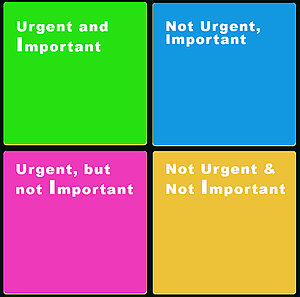The Eisenhower Matrix: How To Improve your productivity
The Eisenhower Matrix, also known as the Eisenhower Decision Matrix, is a productivity and time management tool that draws its name from Dwight D. Eisenhower, the 34th President of the United States and a former five-star general in the U.S. Army. While it's often associated with President Eisenhower, the matrix itself wasn't directly created or named by him. Instead, it is based on his approach to decision-making and time management.
What is the Eisenhower Matrix?
The Eisenhower Matrix is a powerful time management and prioritization technique. This matrix is designed to help individuals prioritize tasks and make efficient decisions by categorizing them into four quadrants based on two key criteria: urgency and importance. Here's a breakdown of the four quadrants:
- Urgent and Important (Do First): Tasks in this quadrant are both urgent and important. They require immediate attention and should be completed as soon as possible. These tasks often have pressing deadlines or significant consequences if not addressed promptly. Examples include critical work assignments, emergencies, and health-related issues.
- Important, Not Urgent (Schedule): Tasks in this quadrant are important but not time-sensitive. They should be scheduled for a later time or placed on your calendar for future attention. These tasks contribute to long-term goals and personal development but don't require immediate action. Examples include strategic planning, exercise, relationship-building, and skill development.
- Urgent, Not Important (Delegate): Tasks in this quadrant are urgent but not particularly important for you to handle personally. Delegation is a key strategy here. You should assign these tasks to others whenever possible to free up your time for more critical matters. Examples include routine administrative tasks, interruptions, and minor requests.
- Not Urgent and Not Important (Eliminate): Tasks in this quadrant are neither urgent nor important. They often represent distractions or time-wasters and should be minimized or eliminated from your daily activities. This frees up time for tasks that align with your goals and priorities. Examples include excessive social media use, mindless web browsing, and unnecessary meetings.
The Eisenhower Matrix has become a widely used framework for effective decision-making and time management. It helps individuals and professionals prioritize tasks, reduce stress, and focus their efforts on activities that align with their goals and values. The matrix's enduring popularity is a testament to its practicality and relevance in today's fast-paced world.
How to apply the Eisenhower Matrix?

Applying the Eisenhower Matrix involves systematically categorizing your tasks based on their urgency and importance and then taking appropriate actions based on their placement in the matrix. All you will need is a pen and a notebook. List Your Tasks: Start by making a list of all the tasks you need to complete. This can include work-related tasks, personal chores, and any other responsibilities. Divide another page into 4 regions by drawing a vertical and a horizontal line in the middle of the paper. Now follow the easy step-by-step guide on how to use this matrix effectively:
Assess Urgency and Importance:
- Urgency: Determine which tasks require immediate attention due to deadlines, obligations, or potential consequences if not completed soon.
- Importance: Evaluate the significance of each task in relation to your goals, values, and long-term objectives.
Place Tasks in Quadrants:
- Quadrant 1 (Urgent and Important - Do First): Identify tasks that are both urgent and important. These should be your top priority. Complete them as soon as possible to prevent crises or missed opportunities.
- Quadrant 2 (Important, Not Urgent - Schedule): Recognize tasks that are important for your long-term goals but not immediately time-sensitive. Schedule these tasks in your calendar or to-do list to ensure they receive attention.
- Quadrant 3 (Urgent, Not Important - Delegate): Identify tasks that are urgent but don't require your personal attention. Delegate these tasks to others if possible. Delegating frees up your time for higher-priority work.
- Quadrant 4 (Not Urgent and Not Important - Eliminate): Find tasks that are neither urgent nor important. Consider eliminating or minimizing these tasks to reduce time-wasting activities.
Take Action:
- Quadrant 1: Start working on tasks in this quadrant immediately. Focus on completing them with your full attention.
- Quadrant 2: Schedule these tasks on your calendar and commit to completing them as planned.
- Quadrant 3: Delegate these tasks to the appropriate individuals or team members. Ensure they have the necessary resources to complete them.
- Quadrant 4: Be conscious of activities in this quadrant and aim to minimize or eliminate them from your routine. You can approach them in your free time.
Regularly Review and Adjust:
- Continuously assess new tasks as they arise and assign them to the appropriate quadrant.
- Periodically review your task list and update the categorization as priorities change.
- Strive to spend more time in Quadrant 2, focusing on important but not urgent tasks, to prevent crises and proactively work toward your goals.
Maintain Balance:
- Striking a balance between the quadrants is key to effective time management. Avoid overloading Quadrant 1 or spending excessive time on unimportant tasks in Quadrant 4.
The Eisenhower Matrix helps you make informed decisions about how to allocate your time and resources, ensuring that you concentrate on tasks that align with your objectives and minimize unnecessary stress and distractions. By consistently applying this matrix, you can enhance your productivity and achieve better outcomes in both your personal and professional life.
Advantages of Eisenhower Matrix
The Eisenhower Matrix offers several advantages that can significantly improve your productivity and decision-making:
- Prioritization: It provides a clear framework for categorizing tasks based on their urgency and importance, making it easier to identify priorities.
- Focused Attention: By categorizing tasks, it encourages you to allocate your time and energy to the most crucial tasks, ensuring that you give them the attention they deserve.
- Effective Time Management: The matrix helps you allocate your time efficiently, ensuring that you address both immediate needs and long-term goals.
- Reduced Procrastination: It combats procrastination by highlighting the importance of addressing urgent and important tasks promptly.
- Stress Reduction: Prioritizing tasks and addressing urgent matters promptly can reduce stress, as you're less likely to feel overwhelmed by impending deadlines or crises.
- Better Decision-Making: It aids in making informed decisions about how to use your time and resources effectively.
- Goal Alignment: By focusing on important, non-urgent tasks (Quadrant 2), you can align your daily activities with your long-term goals and values.
- Improved Productivity: The matrix encourages you to spend more time on tasks that contribute to your personal and professional growth, which can lead to increased productivity.
- Enhanced Work-Life Balance: By prioritizing tasks effectively, you can create a better balance between work and personal life.
- Task Delegation: It prompts you to delegate tasks that are urgent but not important, freeing up your time for more meaningful work.
- Clearer Decision Criteria: The matrix provides a structured way to determine whether a task is worth your immediate attention or can be scheduled for later.
- Consistency: Regularly applying the Eisenhower Matrix can lead to consistent and efficient work habits.
- Time for Personal Growth: It encourages you to invest time in self-improvement, skill development, and activities that enhance your overall well-being.
- Reduced Overwhelm: Breaking tasks into categories makes it easier to manage and tackle them without feeling overwhelmed.
- Improved Accountability: The matrix helps you take ownership of your tasks and prioritize your responsibilities.
Overall, the Eisenhower Matrix is a valuable tool for optimizing your time, reducing stress, and aligning your activities with your goals and values. It's particularly useful for professionals, students, and individuals seeking a structured approach to time management and decision-making.
The Eisenhower Matrix provides a visual framework for assessing tasks and making decisions about how to allocate your time and energy effectively. By categorizing tasks into these four quadrants, you can gain clarity on what truly matters and focus your efforts on high-impact activities. It's a valuable tool for enhancing productivity, reducing stress, and achieving both short-term and long-term goals.
